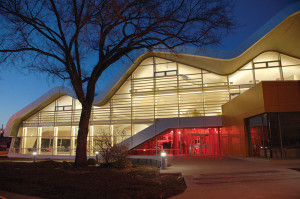Fast + Epp was an Outstanding Award Winner for the Jasper Place Library project in the 2014 NCSEA Annual Excellence in Structural Engineering awards program (Category – New Buildings under $10M).
The City of Edmonton recognizes the value of building high-quality civic facilities for its citizens; hence the architectural response for their newest library that called for a striking free-form clear span facility with maximum daylight penetration.
Fast + Epp collaborated with Hughes Condon Marler Architects and Dub Architects to construct Jasper Place Library, a 15,000 square foot replacement of an existing facility. Predominantly cast-in-place concrete on piles, the primary feature is the expressive curved plate concrete roof that spans the entire library space, punctuated with skylights.
The structural design team faced numerous challenges in the execution of the design, not the least of which was assuring the Client that the proposed structural concept was both safe and buildable. In addition, it was desired that the library would act as the civic heart of a neighbourhood, and that its architecture would be reflective of that concept. The goal was to create a flexible, open space that could adapt to the needs of the library as it evolves in the future.
The unusual structural design consists of a concrete roof slab that cascades into concrete walls at two sides and is supported by light steel columns at the front and back. The roof relies on the deep wave form to clear span the space and generous allowance was made for skylight openings. This design concept is not reliant on additional shear walls or bracing for lateral stability, with the result being a structure that appears to float under maximum daylight penetration.
To maximize the effect of a ‘floating’ roof structure, engineers eliminated bracing or shear walls in the normal-to-wave axis direction. Typical frame action relying on a 300-mm-thick (12-inch) slab/column structure to transfer lateral loads over an effective 30-meter (98-foot) building width would result in unacceptable stresses and deformations. The ingenuity of the structural solution lies in the system availing itself of the inherent longitudinal stiffness of each wave. The ‘spring stiffness’ of each wave reduces the effective frame width to the distance between the axis of the wall columns and adjacent waves, thereby providing the necessary strength and stiffness when subjected to wind and seismic loading.
Fast + Epp embarked on a series of analyses to determine the wave shapes and attendant skylight openings in the roof slab that would result in optimal structural strength and architectural effect. Cast-in-place concrete as well as wood and steel frame solutions were all considered. A concrete option with post-tensioned ‘troughs’ became the preferred solution as a result of the anticipated economy, ease of incorporating organically-shaped openings and its clean architectural expression. The final design incorporates varying wave heights – both normal and parallel to the axes of the waves. Location and size criteria for skylights and acoustic panel depressions were established, enabling generous slab perforations of up to 10 square meters (108 square feet).
A key challenge lay in how to deal with the large cantilevered overhang condition near the front entry of the building – both from a structural strength and thermal bridging point of view. Schoeck Isokorb thermal breaks from Germany were incorporated to minimize thermal bridging in extreme cold climate conditions. A combination of cantilever behaviour as well as two-way slab action in the wedge-shaped corner was relied upon to achieve the necessary structural strength.
Accommodating the large punching shear forces in column support regions that arose from evenly-spaced columns that did not always align with stiff peak and trough points was another challenge. This was successfully dealt with by reinforcing the high-stress regions with stud rails.
Constructability challenges were also identified early in the design process, and the City solicited an expert opinion to advise whether the design was both structurally safe and achievable in the Alberta construction climate. Fast + Epp showed the Client and peer reviewer precedent cases of complex concrete structural forms while explaining the inherent logic of the design – including the use of post-tensioning in the trough regions to control deformations. However, it was not until a satisfactory construction procedure was proposed, accompanied by detailed costing, that these fears were adequately allayed and the go-ahead for final design and construction was given.
The project achieved economy of design by incorporating flat surfaces between the peaks and valleys. It was also proposed to pour the flatter slopes, including the valleys, without top forms prior to pouring the steeper sloped roof and peak portions. This simplified the formwork and enabled pouring of the sloped roof surfaces without excessive wet concrete pressures in the trough regions.
With the digitalization of reading material becoming more popular, the City of Edmonton wanted to create a space that would house tangible reading material, and more importantly serve as a social space for the community. The final design features an open space devoid of columns and allows for the opportunity of maximum social potential in the coming years.
Targeting LEED Silver, the striking architectural form and ample daylight of Jasper Place Library has resulted in a happy and sustainable space for users. Favorable feedback from both the Client and the public has testified to the value of creative design.▪

